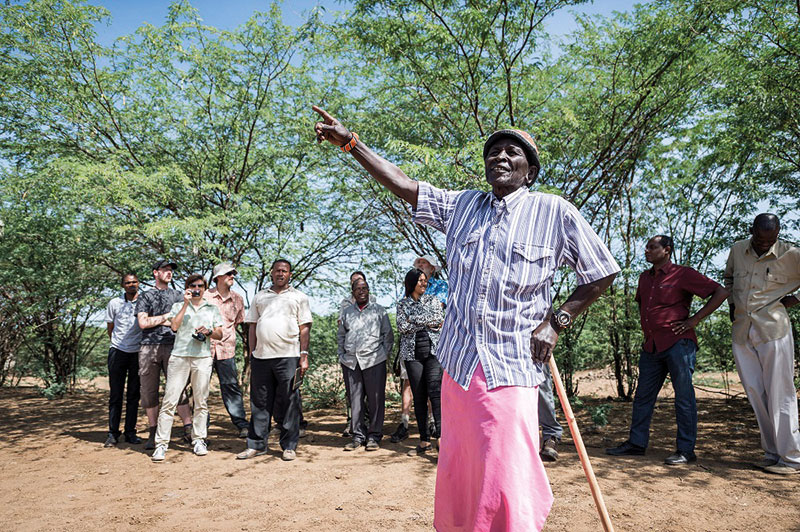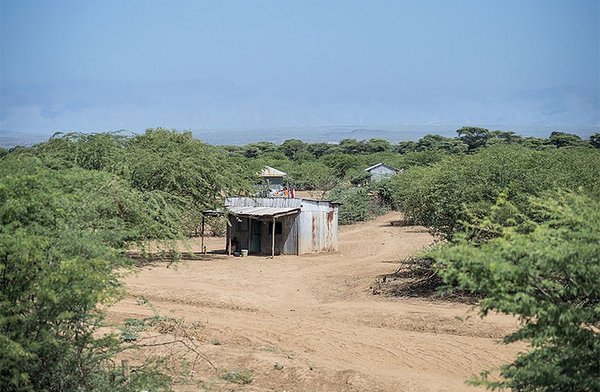 Download this article in magazine layout
Download this article in magazine layout
- Share this article
- Subscribe to our newsletter
Woody weeds – the underestimated threat to biodiversity
Biodiversity loss is happening at an unprecedented rate. The Earth.org Movement reports that “biodiversity is declining faster than at any time in human history. The average abundance of native species in most major land-based habitats has fallen by at least 20 per cent since 1900.” But what does this mean for life on Earth? The uncomfortable truth, as explained in The Lancet, is that it “undermines ecosystems’ abilities to function effectively and efficiently and this undermines nature’s ability to support a healthy environment”. Without this, we and other species cannot survive.
Biodiversity loss increases our vulnerability to climate change and limits options for climate adaptation. Ultimately, it threatens nature-based systems that are fundamental to our survival, like food production. Rural communities around the world that produce food are at most risk of biodiversity loss. Although the world’s poorest countries are home to the greatest array of biodiversity, they are now the ones bearing the brunt of the threat. We must take action today.
Prosopis juliflora – from a useful plant to a pest
Invasive species are one of the major drivers of biodiversity loss. After habitat loss, they are the second greatest threat to biodiversity. Invasive species are living organisms, including plants, that have been moved without their natural enemies from one part of the world to another, where they then spread and thrive. They can have devastating effects on ecosystems. Take the woody shrub Prosopis juliflora (see Box), for example. In the 1970s, Prosopis was brought into Eastern Africa from the Americas as a source of fodder and wood, as well as being considered a solution to reducing erosion on degraded land. Today, it poses a significant threat to grasslands in East Africa. Its introduction has had unforeseen consequences as it has spread and crowded out native biodiversity.
Prosopis
Prosopis has been rated as one of the most invasive plant species world-wide. It is a very drought- and salt-tolerant shrub or small tree which binds nitrogen. Prosopis juliflora has adapted to a wide range of soils and types of habitat. A mature plant can produce hundreds of thousands of seeds, which are capable of germinating for years. The seed is spread by grazers. The thorns and bush growth enable P. juliflora to rapidly block paths and make entire areas impenetrable.
In the Afar region of Ethiopia, CABI scientists have researched the spread of Prosopis and discovered that the weed has encroached upon 1.2 million hectares of land during the past 35 years. This represents more than 14 per cent of the region’s total area, and the plant is expected to continue to spread. In Afar, this growth has caused a 25 per cent decrease in grasslands, which are critical ecosystems for wildlife and for absorbing carbon dioxide. The weed also consumes 50 per cent of the average rainfall in the area; this thirsty plant worsens the effects of climate change.
Huge monocultures of Prosopis have harmed natural habitats and the people who rely on them. Impacts include the loss of grazing land and access to water, a decline in biodiversity, reduced human health and more conflicts between humans and wildlife, as well as among humans themselves. In East Africa, the proliferation of woody weeds has had a significant negative impact on the livelihoods of pastoralists in Baringo County, Kenya.
Controlling woody weeds naturally
Farmers and land managers often turn to pesticides to try to control the spread of invasive weeds. But use of chemicals can have equally devastating effects on the environment. They can also harm human health. Manual removal of the weeds – of woody shrubs like Prosopis especially – can be incredibly difficult and labour-intensive. Sometimes, manual control can cause weeds to spread even further. But there is another way to handle the problem. Nature-based solutions, like the use of living organisms, such as insects or pathogens, are effective alternatives to chemical controls and can address biodiversity loss. They can control specific pests, diseases and weeds in a way that minimises environmental harm. By contributing to cataloguing and conserving global biodiversity, we can safeguard ecosystems for the benefit of human and environmental wellbeing.

A visit to communities in Baringo County, where woody weeds have caused them to consider management strategies for the invasive Prosopis tree.
Photo: Sven Torfinn for CABI
In the case of woody weeds, CABI is spearheading the Woody Weeds+ project. Initiated in 2021, the project builds upon previous project work by its predecessor Woody Weeds which generated and shared knowledge on the impacts of woody invasive alien species in Ethiopia, Kenya and Tanzania. Woody Weeds+ involves supporting the implementation of Kenya’s recently adopted National Prosopis Strategy. The project generates and shares evidence-based knowledge about the impact and spread of invasive plants on landscapes, as well as co-developing sustainable land management strategies to control them. By collectively addressing land degradation caused by woody weeds, the project supports communities, arming them with information to build local adaptive capacity and restore ecosystem services that are essential for coping with climate impacts.
Depending on the size of invasion and land assets, different management objectives (prevention, early detection rapid response [EDRR] or management) and different management techniques (surveillance, mechanical, chemical or biological control) will be implemented. While individual trees or small invasions can usually be best removed mechanically, biological control is the method of choice when the tree is already widespread. When biocontrol is unavailable, targeted use of chemical herbicides becomes necessary. In order to provide the knowledge needed for this, the Woody Weeds+ project is setting up herbicide efficacy trials in Kenya’s Baringo and Isiolo Counties, applying them in very targeted ways.
In Tanzania, CABI is helping to protect habitats around Lake Manyara and Lake Natron from the Prosopis invasion. Invasions around the Lake Natron basin are just starting, and visits to pastoralist communities here reveal just how important it is to prevent the spread of woody weeds to pasturelands.
A comprehensive approach to help preventing biodiversity loss
Many solutions exist that can help to prevent biodiversity loss. An important first step is to understand the spread of invasive weeds. This can be done with field-based research that helps us to monitor changes in species distribution over time. Minimising the disruption of ecosystems by invasive species is another option. By documenting the spread of and threat from these species, we can help countries produce plans for their management. This means working across various landscapes with a range of organisations and stakeholders. The Woody Weeds+ project is a good example of bringing together people from local women’s groups to forestry researchers and land conservancies. In the Merti plateau of Kenya’s Isiolo County, for example, the women’ groups have routines to clear prosopis. They use dry cow dung to burn the trees at the base, thus killing them, which results in lasting removal.
Through the identification, development and release of new and safe biological control agents, we can help to protect biodiversity both by reducing the need for toxic pesticide use in agro-ecosystems and by supporting the restoration of ecosystems that have been degraded by invasion. By working in partnership with governments, we can develop and implement landscape-scale invasive species management strategies that reduce negative effects on biodiversity and ecosystem service delivery, while sustaining livelihoods. To achieve resilience, for example, the Woody Weeds+ project emphasises the importance of inclusive governance approaches.
In relation to agriculture, we can promote nature-based solutions, including Integrated Pest Management (IPM). We can also increase the availability and use of low-risk bioprotection products – such as biopesticides and invertebrate biocontrol agents – that conserve biodiversity. Recent research by CABI scientist has shown that cut stump and basal bark herbicide application and manual uprooting were highly effective in between 85-100 per cent of cases where the woody weeds were removed.
Further down the line, the Wood Weeds+ project will continue to support the implementation of the National Prosopis Strategy jointly with relevant stakeholders, in a target area stretching from West to East along the southern edge of Kenya’s northern rangelands, targeting areas in Baringo, Isiolo and Tana River counties. This also aligns with the Darwin Initiative project which is currently active in Tanzania and compliments the National Invasive Species Strategy and Action Plan (NISSAP). This is a nationwide sectoral document aimed at protecting Tanzania’s biodiversity, ecosystem services, and livelihood assets from invasive species and their negative impacts.
Hariet Hinz is Global Director for Invasive Species at CABI and is based in Delémont, Switzerland. She holds a BSc in Horticulture, an MSc in Pest Management and Applied Entomology and a PhD in Ecology and Biology. Hariet has been leading the Biological Weed Control Programme at CABI’s centre in Switzerland since 2006 and is an Affiliated Professor at the University of Idaho, USA.
Contact: h.hinz@cabi.org
References
Earth.org. 6 Biodiversity Loss Statistics That Will Blow Your Mind
Dilys Roe (2019). Biodiversity loss – more than an environmental emergency. In: The Lancet. Available at:
https://www.thelancet.com/journals/lanplh/article/PIIS2542-5196(19)30113-5/fulltext#:~:text=Loss%20of%20biodiversity%20undermines%20ecosystems,reduces%20nature%27s%20resilience%20to%20change
https://www.cabi.org/what-we-do/invasive-species/
https://www.cabi.org/what-we-do/invasive-species/biocontrol/




